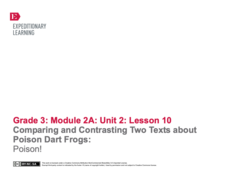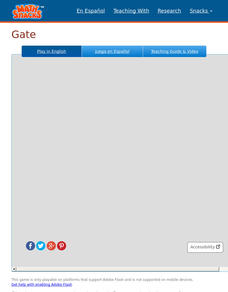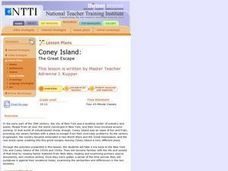NET Foundation for Television
1850-1874 Native Americans and Settlers
Did Western settlers receiving free land from the Homestead Act realize it wasn't really free at all? Scholars investigate the impact Western expansion had on Native American culture in the mid-1800s. They use documents, timelines, and...
NET Foundation for Television
1850-1874 African American Settlers
Go West, young man! Scholars investigate the impact of African American settlers moving to the Nebraska territory, following the passage of the Kansas-Nebraska Act in the mid 1800s. Using primary sources, timelines, maps, and...
Mathematics Vision Project
Module 1: Functions and Their Inverses
Undo a function to create a new one. The inverse of a function does just that. An inquiry-based lesson examines the result of reversing the variables of a function, beginning with linear patterns and advancing to quadratic and...
Concord Consortium
Cities and Gas Stations
In Utah, one stretch of highway goes for 106 miles without a single gas station. Where should people build one? Scholars face the dilemma of where to place a new gas station between three cities. They consider distance and proximity to...
PBS
Rain Shadows
Satellite images from NASA help scholars focus on the similarities on the planet rather than the differences. The photos from the installment of a larger PBS series exploring weather and climate compare geological formations in the...
PBS
The Lowdown — Exploring Changing Obesity Rates through Ratios and Graphs
Math and medicine go hand-in-hand. After viewing several infographics on historical adult obesity rates, pupils consider how they have changed over time. They then use percentages to create a new graph and write a list of questions the...
Ashbrook Center at Ashland University
The Constitutional Convention
Imagine sitting down with representatives of your school to write a new student handbook. What arguments would ensue? How would compromises be made to finish the project? Scholars research the Constitutional Convention using a directory...
University of Minnesota
Making an Immigrant Story
Budding historians research the trip immigrants to the United States take and the reasons behind their willingness to start over in a new place. Groups create their own video lessons outlining the story of human migration from departure...
Sir Peter Blake Trust
Learn About Leadership
Sir Peter Blake was an award-winning New Zealand yachtsman who was killed by pirates in 2001. Scholars learn about his leadership qualities in a fun lesson that combines games, writing, and discussion. Pupils also reflect on ideas of...
EngageNY
Comparing and Contrasting Two Texts about Poison Dart Frogs: Poison!
Scholars compare and contrast two informational texts about Poison Dart Frogs. A brief vocabulary review and discussion lead the way to a two-part close reading—the first reading for gist the second reading for details. Followed by a...
EngageNY
Scaffolding for Essay: Examining a Model and Introducing the NYS Grade 6–8 Expository Writing Evaluation Rubric
Write it down. Scholars take a close look at essay writing by examining the New York state writing rubric. They then discuss a model essay and compare the model essay to the What Makes a Literary Analysis Essay Effective? Anchor Chart....
New Mexico State University
Gate
Build numbers with place value to save the day. Pupils use the keyboard to control the digits in the hundredths through hundreds place to create target numbers to destroy shadows. As participants build the numbers, a number line shows...
EngageNY
Determining Theme: Reading Myths in “Expert Groups”
Leave it to the experts. Scholars work in expert groups to analyze new myths. Each group is assigned to become an expert on either The
Fates, The Story of Medusa and Athena, or Theseus and the Minotaur. They answer questions and discuss...
Museum of Science
Recycled Paper
Watch paper form anew. Scholars take part in an activity where they create new decorative paper from used white and colored office paper. They use a blender to make a pulp slurry, then place it into molds to form the paper. They learn...
Bonneville
Researching Chemicals and Materials for Solar Cell Construction
Revolutionize the solar cell industry with a new design. The 10th of 14 lessons in the Cost Effective Solar Cells unit has pupils start a project in which they design a unique solar cell. They receive an introduction to the project,...
Museum of the American Revolution
Through Their Eyes: Major Causes and Events of the American Revolution
Looking for an efficient way to explore the causes and results of the American Revolution? The American Revolution Museum offers a seven-lesson series to hit the highlights of this turning point, using primary sources and activities such...
Academy of American Poets
Teach This Poem: "The Shapes of Leaves" by Arthur Sze
Arthur Sze's poem, "The Shapes of Leaves," encourages young scholars to notice and speak for others who "do not speak." The lesson begins with pupils writing about a tree that they really like. The class then examines an image of...
K20 LEARN
LBJ and Voting Rights
Challenges to voting rights is not a new thing. Using President Lyndon B. Johnson's 1965 "The American Promise" speech on voting rights as a starting point, young historians research current voting rights laws and challenges.
K20 LEARN
Ecosystems, Human Activity, And Interactions, Oh My!: Human/Environment Interaction
Word clouds about ecosystems hook learners into a instructional activity that explores Yellowstone wildlife. Young scientists create cause-and-effect relationships after examining data and recommend solutions to their observed problems....
Curated OER
Why were Americans upset with the British Government?
Fourth graders examine the Revolutionary War in New York State. In this experiential hook lesson, 4th graders adhere to new rules imposed by the teacher. Students document their feelings and frustrations with being taxed on using walk,...
Curated OER
The Slave Market: Slavery, Not Just a Southern Institution
Eleventh graders examine how slavery was related to the economic development of New York. In this American History lesson, 11th graders analyze the primary and secondary sources on the New York Slave Market. Students create a revised...
Curated OER
Not Just Books
Students consider uses of a library and explore the collections at the Morgan Library and Museum in New York City, and create proposals for exhibits of various artifacts.
Curated OER
Today's News, Tomorrow's History
Students read and analyze the historic New York Times front pages, and read an article that focuses on the current housing slump and the effect on state budgets. They answer comprehension questions, then in small groups answer questions...
Curated OER
Coney Island: The Great Escape
Students use primary documents and film to explore the role of Coney Island recreation for New Yorker's at the beginning of the 20th century. They compare the lives of the people in their research to their own.

























